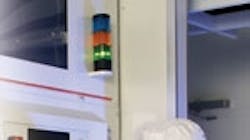When it comes to energy prices, there's little reason to believe that what goes up must come down. And with manufacturing claiming nearly one-third of U.S energy consumption, the heat is on to develop methods to combat skyrocketing fossil fuel costs.
Biofuels, solar and other renewable energy sources may hold promise as power sources of the future, but there appears to be little hope of them providing significant immediate relief. Indeed, according to the U.S. Department of Energy (DOE), even in the longer term, while renewables' growth is predicted to escalate, oil, coal and natural gas will continue to provide roughly the same 86% share of the total U.S. primary energy supply in 2030 that they do today, absent regulatory changes.
Where manufacturers can and are reaping immediate benefits is by increasing the energy efficiency of their facilities. The U.S. government is even lending a helping hand via energy savings assessments it has been conducting at energy-intensive manufacturing plants. As of Nov. 30, the DOE had completed 190 assessments and identified potential energy savings of some $395 million. After six months, 54 plants had reported energy-saving projects totaling $87 million in various stages of completion.
Those 54 plants represent a mere fraction of the number of manufacturers who are engaged in efforts to reduce their energy usage. In truth, there is no shortage of examples of manufacturers engaged in getting the most production from every unit of energy, eliminating wasted energy and making smarter energy choices.
Multipronged Approach
For instance, at Haworth Inc.'s Kentwood, Mich., plant, employees take a team approach to reducing energy consumption at the 120,000-square-foot facility, which manufactures raised-access floor products. Their energy initiative launched in August 2005 with the creation of the Haworth Kentwood Energy Reduction Team, a cross-functional team of six to eight people that includes members from across all functions at the plant, including management, production, maintenance and administrative.
Their efforts began with a straightforward brainstorming session that resulted in an initial list of 50 to 60 ideas to conserve energy, according to Steven Kooy, a Haworth environmental engineer and member of the energy reduction team. "Then we said, 'OK, now what's practical?'" he says.
In the nearly one-and-one-half years since the team began, numerous practical ideas have been implemented, resulting in substantial savings. These include some relatively easy fixes, such as eliminating air leaks in the air compressor system. "The less air that leaks, the less your air compressors are used," Kooy explains. "It's a pretty major deal; it's kind of like a dripping faucet."
The plant realigned overhead doors, which had become misaligned over time and allowed cold, outside air easy access to the indoors. "When the common drive is on production, you kind of forget the house you live in, so to speak," Kooy notes.
The plant dismantled an unused drying oven (one of two at the plant), which had been rendered unnecessary due to manufacturing-related changes at the plant. The oven's rigid foam insulation, which was in good shape, then was used to insulate areas of the facility. "Instead of ripping it down and throwing it away in the landfill, we were able to reclaim it and use it on the walls," Kooy says. Kentwood also tweaked its product drying engineering specifications to finish curing processes outside of the oven, reducing the amount of energy used. Other improvements include turning off lights strategically by zone and by shift.
A major contributor to the plant's energy savings, however, was a rethinking and resetting of the facility's temperatures. Kentwood set the office temperature at 70 F, while the plant temperature dropped to 60 F. In addition, site employees received Haworth Kentwood sweatshirts.
Not A Lesson In Sacrifice
Don't get the idea, though, that plant workers were asked to sacrifice their health or comfort in Kentwood's effort to reduce its energy usage, Kooy points out. "We care about our people. We certainly don't want them getting cold or sick," he says.
Instead the energy team looked at the processes underway in the plant and how those processes impacted workers' comfort. "We found that some of these people were wearing short sleeves in the winter because they're working, they're moving around, but -- more importantly -- the processes around them, the ovens and all the various equipment, are warm. So they themselves were warm," Kooy says. "Manufacturing spaces aren't designed to take into account all the processes and then the changes. So we started to look at where the people are, where we need the heat, and where we don't need the heat." Temperatures were reduced gradually to gauge an appropriate setting.
Haworth's Kentwood plant has enjoyed substantial cost savings due to its energy-reduction program. Gross consumption of natural gas in the first quarter of 2006 was about 35% below the same quarter in the previous year. On a per-equivalent-unit basis, natural gas consumption also is down. Similarly, while electrical costs have increased, the Kentwood plant's consumption of electrical power is down significantly.
Kooy adds that the entire plant workforce received training on energy efficiency and had an opportunity to share their ideas on the measures being considered at the plant.
IBM Burlington says its focus on energy conservation dates back to the mid-1970s, and it claims a 16-year history of documented energy savings. Located in Essex Junction, Vermont (10 miles from Burlington), the campus employs some 5,700 people on 750 acres in more than 20 major buildings and as many smaller ones. The development, manufacture and test of semiconductors occur here.
Like Haworth's Kentwood plant, IBM Burlington relies heavily on its workforce to generate energy-savings ideas. Indeed, the organization has designated energy representatives and holds brainstorming sessions at least annually to generate energy-reduction ideas. In 2006, IBM Burlington augmented those brainstorming sessions with a sitewide energy-savings contest that rewards ideas in specific categories. Winners in each category receive $500.
The Burlington site's recent energy-efficiency efforts include its main cooling system, which pumps chilled water throughout the site. Jonathan Aldrich, the site energy manager, explains that over time the water becomes contaminated with particulates, creating rough spots in the pumps and generating more friction -- ultimately making the pumps less efficient.
In response, the site has begun applying a Belzona coating to the pumps' housings. The coating creates a smooth surface, reducing friction and increasing the pumps' efficiency. It also prevents the rough spots from recurring, Aldrich says, so it should reduce maintenance costs as well.
Four of the plant's 12 pumps have received the coating, and eventually all of them will. Burlington has been making its pump modifications during the winter months, when all of the site's chillers aren't required to be operational.
As to savings, Aldrich says the coating has reduced energy consumption by about 7% per pump in the affected pumps, which translates to about $10,000 per pump per year.
Eye On Lighting
IBM Burlington has also turned to -- and in some cases turned off -- lighting to improve energy usage. For example, the site has upgraded the traffic lights on its main roadways from incandescent bulbs to an LED (light emitting diode) lighting system. Energy consumption has dropped by 90%, as has maintenance. The LEDs have a 10-year replacement cycle compared with six months for the incandescent bulbs, according to Aldrich. "It's a significant reduction in cost as technology has advanced," he notes. The initial capital outlay to change 16 lighting fixtures was $20,000.
The manufacturer also has:
- Installed computer-controlled timers in several buildings that turn lights off during non-work hours. The lights can be activated via telephone if employees come in during non-work hours. Costs savings are about $15,000 per year, IBM says, after the initial capital outlay. The program also qualifies for a Vermont rebate for efficiency measures.
- In certain buildings, T12 fluorescent lights were replaced with T8 fluorescents, which produce the same light for about 60% of the power consumption, Aldrich estimates. The site replaced ballasts and bulbs, but the fixtures remained the same.
- IBM added motion-sensor switches to some of the common areas, such as restrooms and copier rooms. The sensors automatically turn lights off after one-half hour of inactivity. "You have multiple people going in, but nobody knows they are the last person so nobody ever shuts the lights off," Aldrich says, noting that the motion sensors have another benefit. "Psychologically, people get reminded of energy conservation when they walk in a dark room and bang, automatically the lights come on. It's a nice reminder that we do pay attention to energy and energy costs."
At Rochester, N.Y.-based Xerox Corp., innovation is aiding the company's efforts to conserve energy. Specifically, Xerox has altered the "recipe" of certain printer toners to reduce the amount of energy needed to produce those toners by up to 22%.
"The manufacturing of supplies -- especially toner manufacturing -- is among the most energy-intensive activities within Xerox," says John R. Laing, senior vice president, Xerox Supplies Delivery Unit.
And the most energy-intensive step in making toner is the grinding process, which pulverizes large particles of plastics, colorants and other ingredients into smaller, more uniform particles. The grinding process consumes up to 40% of the total energy used for making toner.
Xerox engineers have discovered that adding a chemical ingredient called an embrittling agent to the toner recipe makes the toner particles easier to grind, thus making the entire process more energy efficient. The company says that depending on the product family, the addition of the embrittling agent can as much as double the grinding rate.
In addition to conserving energy, Xerox expects its innovation to help the company avoid more than 18,000 metric tons of carbon dioxide emissions by 2008. Throughout its global operations, Xerox is working to improve energy efficiency by 30% compared with 2002 levels.
About the Author
Jill Jusko
Bio: Jill Jusko is executive editor for IndustryWeek. She has been writing about manufacturing operations leadership for more than 20 years. Her coverage spotlights companies that are in pursuit of world-class results in quality, productivity, cost and other benchmarks by implementing the latest continuous improvement and lean/Six-Sigma strategies. Jill also coordinates IndustryWeek’s Best Plants Awards Program, which annually salutes the leading manufacturing facilities in North America.
Have a story idea? Send it to [email protected].

